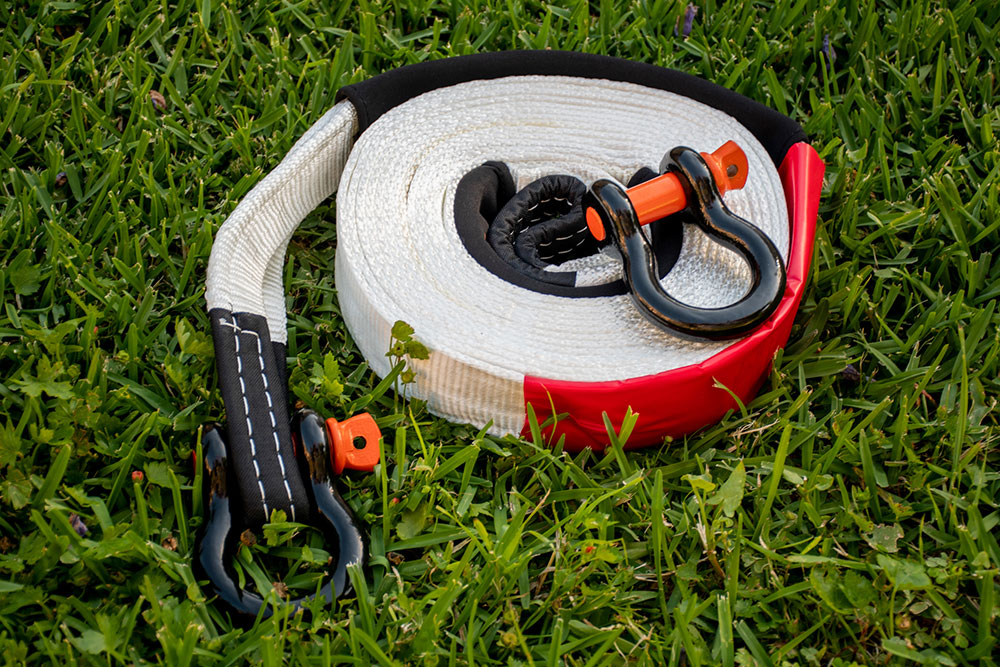How to use snatch straps for vehicle recovery
Used correctly, snatch straps are safe and effective, but improper use can and has caused fatalities.

Snatch straps are often used for off-road vehicle recoveries.
They work to spring or ‘snatch’ the bogged vehicle free due to the energy temporarily stored in the strap as its elasticity allows it to stretch when the recovery vehicle applies a towing load by moving slowly and steadily forward.
This stored energy can make them very dangerous, especially to bystanders.
If the strap is to work correctly it must be matched to the gross vehicle mass (GVM) of the lighter vehicle.
Too light and it may break.
Too heavy and it won’t stretch sufficient to provide the snatch effect and it may cause catastrophic failure of the attachment points due to shock load.
The minimum breaking strain (marked on the strap) should be between two and three times the vehicles GVM.
When setting up for recovery always carefully assess the situation, any hazards, and best direction for the recovery.
Clear mud or sand away from the bogged vehicles wheels and underbody taking account of direction of pull.
The tow vehicle should be no more than 10° from straight in line with bogged vehicle with about 2m less between them than the unstretched length of the strap, which should be laid out between them without kinks or twists.
The strap should only be attached to the vehicle manufacturer’s recommended recovery points or other properly engineered recovery points.
Never use tie-down eyes, tow-balls/towbars, bullbars or suspension components – they aren’t designed for recovery loads.
Vehicle damage and deaths have resulted from failures of these items.
Only use good-quality load-rated (minimum safe working load 3.5 tonnes) shackles when required for vehicle connection. Hand-tighten the pin and back off ¼ turn to help avoid pin binding.
Form a neat ‘S’ shaped loop in that ‘spare’ 2m near the strap’s middle and place a recovery damper bag or heavy blanket across it to act as a recoil damper.
Avoid joining straps if possible and where required, never use shackles or other metal objects for joining – they become deadly missiles if they fail.
To correctly join two straps, take the end of strap one up through the eye of strap two.
Reach down through the eye of strap one and grab strap two behind the eye and lift it up through the eye of strap one.
Pull the entire length of strap two through.
Pull the resulting joint tight with a rolled-up magazine between the straps, so they can be easily separated after use.
Onlookers should not be in front, between or behind the vehicles and at least 1.5 times strap length to the side.
The drivers should agree on who directs and suitable signals.
Some judgement will be needed to select the correct gears, but as a starting point, first for recovery car (or first or second low range, if transfer case equipped) and first or reverse for bogged vehicle, to suit recovery direction.
Don’t use a big run and jerk or lots of speed.
Steadily accelerate at about 10kph and allow the momentum and strap energy to do the job.
As the strap slack takes up the bogged vehicle should also attempt to drive out. Be smooth and avoid wheel spin.
Look after your straps, wash them clean, dry, and store carefully.
Don’t use them as lifting slings or write on them with marker pens.
Related topics
Things to note
The information in this article has been prepared for general information purposes only and is not intended as legal advice or specific advice to any particular person. Any advice contained in the document is general advice, not intended as legal advice or professional advice and does not take into account any person’s particular circumstances. Before acting on anything based on this advice you should consider its appropriateness to you, having regard to your objectives and needs.
Insurance Products (excluding Travel Insurance) are issued by RACQ Insurance Limited ABN 50 009 704 152 (RACQI) and arranged by its agent, RACQ Distribution Services Pty Ltd (RDS) ABN 35 116 361 650, AFSL 567130 and RDS' authorised representatives (including RACQ Operations Pty Ltd ABN 80 009 663 414, AR No. 234978 (RACQO). Conditions, limits and exclusions apply. RDS and RACQO are in the RACQ group of companies. One of the companies in the RACQ group of companies has a minority shareholding in RACQI.
RDS and RACQO have not taken your personal objectives, circumstances or needs into account when preparing advice regarding insurance products and you will need to consider whether the advice is appropriate for you. Read the Product Disclosure Statement (PDS) and any applicable Supplementary PDS before making a purchase decision on this product. You can also access our Target Market Determinations on this website. RDS receives a commission from RACQI for the policies it arranges. RACQO receives fees paid for services it provides to RDS. Further details about remuneration are available on request prior to purchasing.
Banking and loan products issued by Members Banking Group Limited ABN 83 087 651 054 AFSL/Australian credit licence 241195 trading as RACQ Bank. Terms, conditions, fees, charges and lending policies apply. This is general advice only and may not be right for you. This information does not take your personal objectives, circumstances or needs into account. Read the disclosure documents for your selected product or service, including the Financial Services Guide and the Terms and Conditions, and consider if appropriate for you before deciding.
Except for RACQ Bank, any RACQ entity referred to on this page is not an authorised deposit-taking institution for the purposes of the Banking Act 1959 (Cth). That entity’s obligations do not represent deposits or other liabilities of RACQ Bank. RACQ Bank does not guarantee or otherwise provide assurance in respect of the obligations of that entity, unless noted otherwise.
RACQ Bank subscribes to the Customer Owned Banking Code of Practice which establishes higher standards than the law requires. The Code reflects modern consumer expectations and developments in approaches to issues such as consumer vulnerability, guarantors, and supporting customers through financial hardship. Please read our Customer Owned Banking Code of Practice page for more information.
RACQ Operations Pty Ltd (ABN 80 009 663 414 AR 000234978) and Members Travel Group Pty Ltd (ABN 45 144 538 803 AR 000432492) are acting as an Authorised Representative of the issuer of the insurance, Tokio Marine & Nichido Fire Insurance Co., Ltd. (ABN 80 000 438 291 AFSL 246 548). Any advice set out above is general in nature only, and does not take into account your objectives, financial situation or needs. Before purchasing any travel products, please consider the RACQ Travel Insurance Product Disclosure Statement (PDS) and the Target Market Determinations (TMDs) that apply to these products. Whilst the PDS outlines the Terms and Conditions of these products, the TMDs outline the intended class of customers that comprise the target market for these travel products. This will allow you to consider which products best suit your objectives, financial situation and needs and consider the products appropriateness to your personal circumstances. TMDs also outline matters involving the distribution and the review of these products. The PDS, Supplementary PDS and TMDs for each travel product can be found here.
